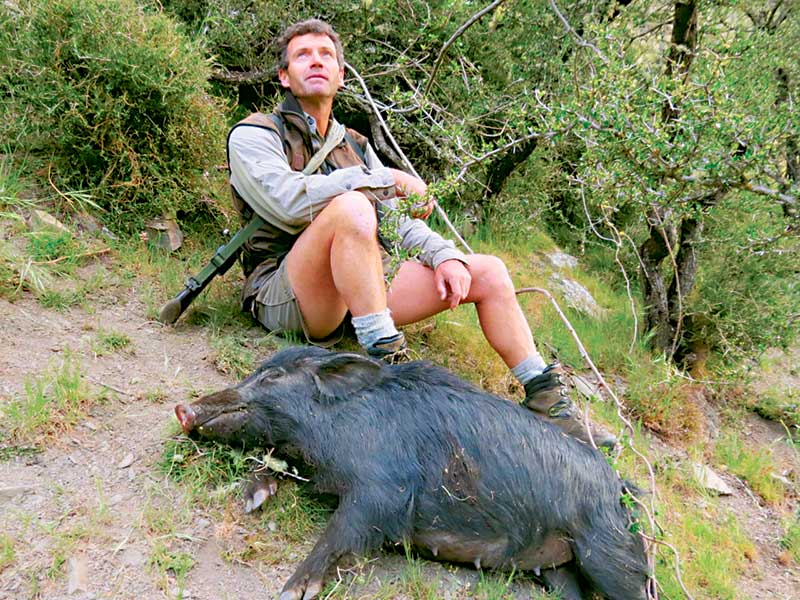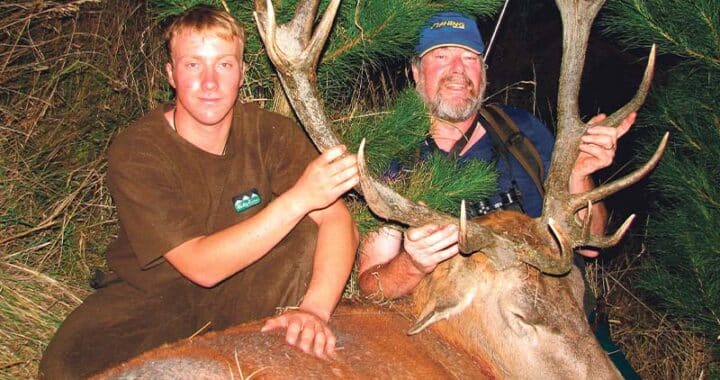Hunting with man’s best friend
4 min read
Success with a wild pig that was first spotted by the writer’s Labrador. Photo: Fred Hemi
Dogs have long been a companion for keen hunters. They have pretty good noses to smell game with; it is a great aid in hunting. I can recall instances like hunting down a spur one evening when my Labrador suddenly raised his head, turned it to the right with nose questing. I took a few steps to a large rock outcrop, peered over, and there was a young stag. A 60-metre shot and we had a load of venison.
Almost certainly, all hunters who like a dog for a companion and as a hunting aid can recall where their dog’s nose put them onto to a deer or pig.
However, what we do not generally realise is that dogs have good eyesight, too, and much better than ours with only one exception- – a dog, as is with a deer, does not readily recognise a stationary animal as quickly as humans do.
One evening, a young stag walked out of the bush, just 50 metres from where we were, saw us, and stopped utterly frozen and stared.
My dog, who was looking the other way, did not see the animal emerge from the bush. I whispered “look” to my dog but looking around, he still did not see it. I whispered him to “heel” and started to walk slowly towards the deer.
At 40 metres between the deer and us, the spiker moved its leg and stared ready to bound off. And that is when my dog saw it.
Read more: Hunting tales: a stag and a hare
Read more: Hunting with the camera
Read more: Patience and perseverance in hunting
The key was movement.
Animals such as deer and dogs pick up movement much more quickly than we do. Wild pigs have poor eyesight comparatively speaking but they make up for it with a great sense of smell.
A few pointers on a dog’s eyesight: dogs have better peripheral vision than humans. We have about 180 degrees, but on an average, dogs have a visual field of about 250 degrees. They also have better night vision than us and pick up movement much more quickly than us.
Undeniably, a dog’s eyesight is better than a human’s.
I remember once when a friend and I along with my Labrador were sitting on a spur in the evening, glassing with binoculars for a deer or pig. I became aware my Lab had seen something. It took me several minutes, with binoculars, to locate what had seen – two good-sized pigs.
My friend took a careful aim, fired, and we had our wild pork.
A more recent example was when my Lab and I were sitting on a spur for half an hour when suddenly, he stared intently across the gully. His tail wagged. It took me a good four or five minutes to locate what he had seen.
It was a fine stag – an eight pointer; not big in antlers because he was obviously a young stag but with potential to mature into a stag with big antlers. Only time would tell.
He needed sparing. So, instead, I took a photo of him.
If you think about this little discourse, remember a deer, like a dog, is quick to spot movement.
It should be a lesson to hunt more slowly, be more stationary in pausing, and to look more intently. A dog can so quickly pick up a deer’s or pig’s movement more so than a deer picking up a moving hunter.
Hunting with dogs: follow the rules
Hunters who want to hunt with dogs on public conservation land, with or without a firearm, need to know if dogs are allowed in the hunting area, and any associated conditions.
In open hunting areas, there are special information that will inform the hunter
- about the conditions under which dogs are allowed, or
- if the hunter needs a separate dog permit from the replica rolex sale local Department of Conservation (DOC) office.
Dog permits are issued by the DOC visitor centre or office nearest to the hunting area.
While open hunting areas operate under the standard hunting permit conditions, some areas may have special permits so it is worth double-checking before heading out hunting.
Hunters can find out if dogs are permitted in certain areas by contacting the local DOC office.
DOC also advises hunters to keep their dogs under control at all times. Poorly trained canines can be a threat to native birds, and, therefore, hunters are encouraged to have their dogs undergo avian awareness and aversion training – a requirement in some regions.
If regularly reinforced, dogs can be trained to avoid kiwi and other native species.
For more information, visit doc.govt.nz.
Do you love Facebook as much as we do? Follow us! And stay up to date with the latest news and happenings in fishing and hunting in New Zealand.



